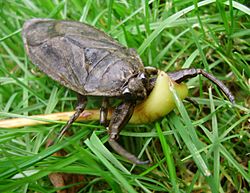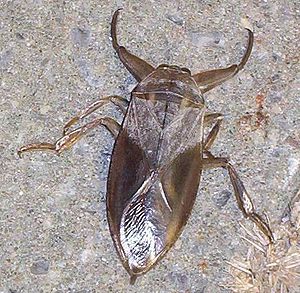Lethocerus americanus facts for kids
Quick facts for kids Lethocerus americanus |
|
|---|---|
 |
|
| Lethocerus americanus | |
| Scientific classification | |
| Kingdom: | |
| Phylum: | |
| Class: | |
| Order: | |
| Family: |
Belostomatidae
|
| Genus: |
Lethocerus
|
| Species: |
L. americanus
|
| Binomial name | |
| Lethocerus americanus (Leidy, 1847)
|
|
Lethocerus americanus is a fascinating insect known as a giant water bug. It belongs to the Belostomatidae family. You can find these bugs in southern Canada and the United States, mainly north of 35°N latitude. They are quite large, usually growing to about 5 to 6 centimeters (2 to 2.4 inches) long.
Contents
What is a Giant Water Bug?
These bugs are often found in watery places like ponds, marshes, and along the edges of lakes and slow-moving streams. Both young bugs (called nymphs) and adult bugs are predators. This means they hunt and eat other smaller creatures.
What do they eat?
Their diet includes other insects, small crustaceans (like tiny crabs or crayfish), tadpoles, snails, and even small fish. The adult bugs are good swimmers, using their back legs to move through the water.
How do they hunt?
Giant water bugs have special front legs that they use to catch and hold onto their prey. Once they've caught something, they inject it with special digestive toxins. They do this using a part of their mouth that works a bit like a mosquito's proboscis. They usually wait about 10 to 15 minutes for the toxins to work before they start eating. Sometimes, several L. americanus bugs might even hunt and share the same meal!
How do they breathe underwater?
When they are underwater, adult bugs breathe air that they trap under their wings. They have two tube-like structures at the back of their body that act like snorkels, helping them get air.
Why are they called "Toe Biters"?
L. americanus bugs are sometimes called "toe biters" because they can deliver a painful bite if you handle them or disturb them. However, they usually prefer to stay away from humans. If they are bothered in the water, they are very fast and can quickly swim away. Their natural camouflage also helps them hide easily.
Even on land, if disturbed, they will first try to escape or pretend to be dead. If you keep bothering them, they might raise their front legs and back end, looking like they're ready to fight. If the disturbance continues, they will use their front legs to grab onto whatever is bothering them and try to bite.
"Electric-Light Bug"
Another common name for them is the "electric-light bug." This is because they are often attracted to electric lights when they fly at night.
How to tell them apart
L. americanus looks very similar to another insect called Benacus griseus. You can tell them apart by looking for grooves on the front legs of L. americanus. These grooves help their lower leg parts fit tightly when folded. They are also very similar to Lethocerus uhleri.
Life Cycle and Reproduction
Female L. americanus bugs lay their eggs on plants near the water's edge. An adult bug might even guard these eggs. The young bugs, called nymphs, hatch about two weeks later.
Adult females will switch between feeding and mating, and they can lay about 150 or more eggs during their lifetime. However, not many nymphs survive to become adults. This is because other predators might eat them, and sometimes even the bugs themselves might eat each other (cannibalism). Adult bugs usually die during the winter months.
Images for kids



